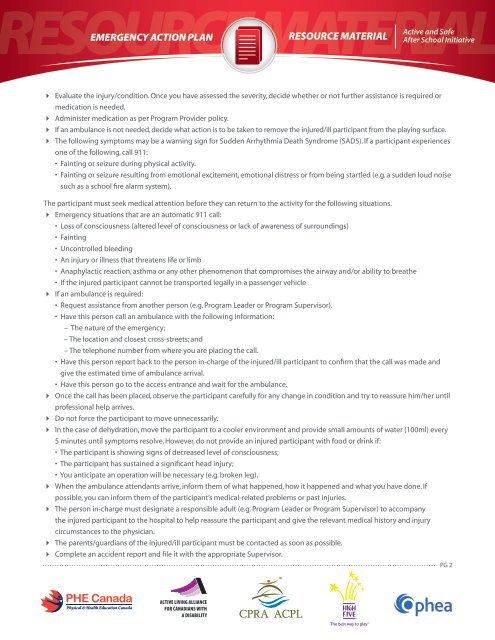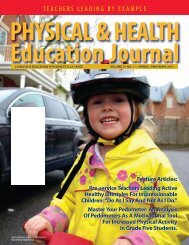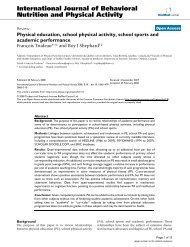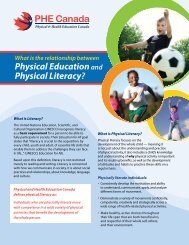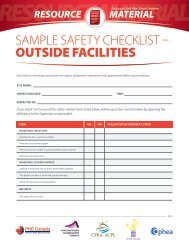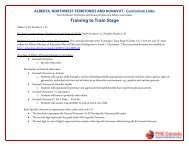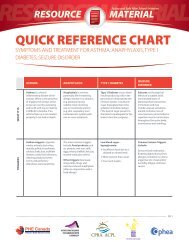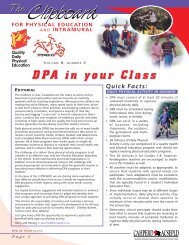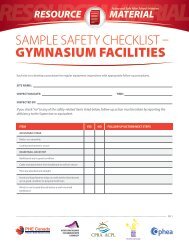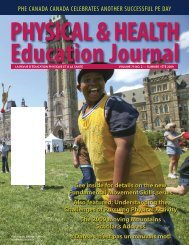SAMPLE EMERGENCY ACTION PLAN - PHE Canada
SAMPLE EMERGENCY ACTION PLAN - PHE Canada
SAMPLE EMERGENCY ACTION PLAN - PHE Canada
You also want an ePaper? Increase the reach of your titles
YUMPU automatically turns print PDFs into web optimized ePapers that Google loves.
esource resource materialEmergency Action PlanActive and SafeAfter School Initiative4 Evaluate the injury/condition. Once you have assessed the severity, decide whether or not further assistance is required ormedication is needed.4 Administer medication as per Program Provider policy.4 If an ambulance is not needed, decide what action is to be taken to remove the injured/ill participant from the playing surface.4 The following symptoms may be a warning sign for Sudden Arrhythmia Death Syndrome (SADS). If a participant experiencesone of the following, call 911:• Fainting or seizure during physical activity.• Fainting or seizure resulting from emotional excitement, emotional distress or from being startled (e.g. a sudden loud noisesuch as a school fire alarm system).The participant must seek medical attention before they can return to the activity for the following situations.4 Emergency situations that are an automatic 911 call:• Loss of consciousness (altered level of consciousness or lack of awareness of surroundings)• Fainting• Uncontrolled bleeding• An injury or illness that threatens life or limb• Anaphylactic reaction, asthma or any other phenomenon that compromises the airway and/or ability to breathe• If the injured participant cannot be transported legally in a passenger vehicle4 If an ambulance is required:• Request assistance from another person (e.g. Program Leader or Program Supervisor).• Have this person call an ambulance with the following information:– The nature of the emergency;– The location and closest cross-streets; and– The telephone number from where you are placing the call.• Have this person report back to the person in-charge of the injured/ill participant to confirm that the call was made andgive the estimated time of ambulance arrival.• Have this person go to the access entrance and wait for the ambulance.4 Once the call has been placed, observe the participant carefully for any change in condition and try to reassure him/her untilprofessional help arrives.4 Do not force the participant to move unnecessarily.4 In the case of dehydration, move the participant to a cooler environment and provide small amounts of water (100ml) every5 minutes until symptoms resolve. However, do not provide an injured participant with food or drink if:• The participant is showing signs of decreased level of consciousness;• The participant has sustained a significant head injury;• You anticipate an operation will be necessary (e.g. broken leg).4 When the ambulance attendants arrive, inform them of what happened, how it happened and what you have done. Ifpossible, you can inform them of the participant’s medical-related problems or past injuries.4 The person in-charge must designate a responsible adult (e.g. Program Leader or Program Supervisor) to accompanythe injured participant to the hospital to help reassure the participant and give the relevant medical history and injurycircumstances to the physician.4 The parents/guardians of the injured/ill participant must be contacted as soon as possible.4 Complete an accident report and file it with the appropriate Supervisor.PG 2


